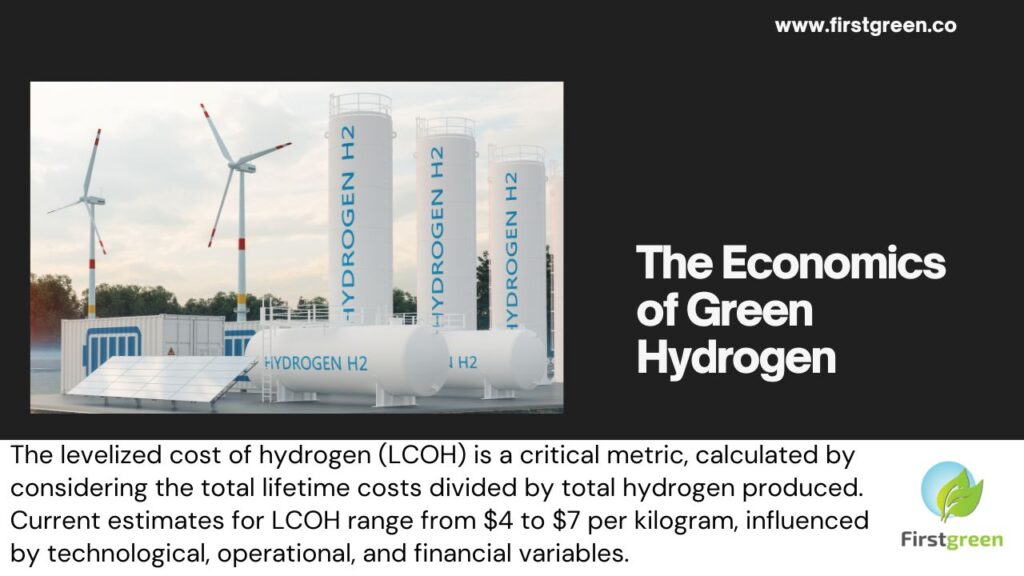
As the world seeks sustainable energy solutions, green hydrogen emerges as a promising contender. Unlike conventional hydrogen production, which relies on fossil fuels, green hydrogen is produced via electrolysis powered by renewable energy sources, such as wind and solar. This article delves into the project economics of green hydrogen, exploring production, storage, transport, and end-use cases.
Production Costs
The financial viability of green hydrogen projects hinges on the capital and operational costs associated with electrolyzers, the devices responsible for water electrolysis. The cost of these systems depends on the technology used, with the two main types being Alkaline and Proton Exchange Membrane (PEM) electrolyzers.
- Alkaline Electrolyzers: Cost-effective and mature, with costs ranging from $500 to $1,000 per kilowatt (kW). They operate optimally under constant load but are less responsive to fluctuations in power supply.
- PEM Electrolyzers: Known for higher efficiency and responsiveness to variable power loads. These are more expensive, ranging from $700 to $1,400 per kW.
Table: Electrolyzer Cost Comparison
| Technology Type | Cost per kW | Efficiency | Responsiveness |
|---|---|---|---|
| Alkaline | $500 – $1,000 | Moderate | Low |
| PEM | $700 – $1,400 | High | High |
Storage and Transportation
Storing and transporting hydrogen poses unique challenges due to its low density and high reactivity. Effective storage options include:
- Gaseous State: Requires high-pressure tanks.
- Liquid State: Involves cooling hydrogen to extremely low temperatures.
- Solid State: Hydrogen is absorbed into other materials.
Table: Hydrogen Storage Methods
| Storage Method | Description | Costs |
|---|---|---|
| Gaseous State | High-pressure tanks | Low |
| Liquid State | Cooled to -253 degrees Celsius | Moderate |
| Solid State | Absorbed in materials | High (developmental) |
Transportation can be facilitated via pipelines, trucks, or ships, depending on the distance and geographical constraints. Retrofitting existing gas pipelines for hydrogen transport is a potential cost-saving measure.
End-Use Cases
Green hydrogen has versatile applications across various industries:
- Transport: Fuel cell electric vehicles (FCEVs) offer a low-carbon alternative to fossil fuels.
- Industry: Used in refining, ammonia production, and as a feedstock for chemical processes.
- Power: Can store excess renewable energy and help balance the grid.
Table: Green Hydrogen End-Use Cases
| Sector | Application | Benefits |
|---|---|---|
| Transport | Fuel for FCEVs | Reduces transportation emissions |
| Industry | Raw material for chemicals | Decreases industrial carbon footprint |
| Power | Energy storage and grid balancing | Enhances renewable energy utilization |
Financial Modeling and Project Viability
Financial models for green hydrogen projects must consider numerous parameters including capex, opex, fuel costs, and potential revenues from hydrogen sales. Government subsidies and long-term off-take agreements can significantly influence the economic feasibility of such projects.
The levelized cost of hydrogen (LCOH) is a critical metric, calculated by considering the total lifetime costs divided by total hydrogen produced. Current estimates for LCOH range from $4 to $7 per kilogram, influenced by technological, operational, and financial variables.
Conclusion
The economic landscape of green hydrogen is complex and varies by region due to differences in energy prices, technology costs, and infrastructure availability. However, with advancements in technology and increased focus on sustainability, green hydrogen has the potential to play a pivotal role in the global energy transition. The development of cost-effective production, storage, and transport technologies will be key to its widespread adoption.
